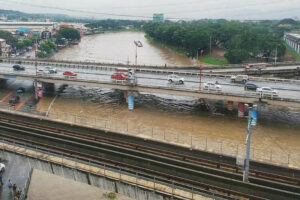THE Department of Public Works and Highways said the administration wants to build more bridges across the Marikina and Pasig rivers.
“We will continue with the construction of more bridges across the Marikina and Pasig rivers so that mobility will be enhanced… because there are just a few bridges connecting the north and south sectors, although the department has already built a few more,” Public Works Secretary Manuel M. Bonoan said on Tuesday at a briefing following the President’s State of the Nation Address (SONA).
He said there will be “five or six” more bridges “across the Pasig River.”
“There is an expressway that will be developed in the eastern corridor of Metro Manila that will go through Pasig, Cainta, all the way to Bulacan, and this is already being implemented,” he added.
Last year, San Miguel Corp. and the government broke ground on the 19.37-kilometer Pasig River Expressway project. The P95-billion project will link the eastern and western cities of Metro Manila and will connect to the Skyway system, integrating the elevated road network to link the north, south, east, and west corridors of the capital.
“We will continue to entice the private sector (via) public-private partnerships (PPP) for transport programs that are viable for the private sector,” Mr. Bonoan said.
At the same time, he noted that the South Luzon Expressway extension to Lucena “is now underway.”
“The other expressway that will be implemented is the Cavite-Laguna Expressway all the way to Tagaytay.”
Metro Pacific Tollways Corp. holds original proponent status for the Cavite-Tagaytay-Batangas Expressway project, a 50.43-kilometer tollway linking the Cavite-Laguna Expressway at Silang East Interchange to Tagaytay City and Nasugbu, Batangas.
In his first address to Congress on Monday, President Ferdinand R. Marcos, Jr. said his administration will “make it more convenient for travelers to go around the country, even to remote areas to help promote undiscovered tourist spots.”
“This program will be led by the Department of Tourism, together with the Department of Public Works and Highways,” he added.
The President promised to continue studying existing proposals, calling infrastructure development of primary importance.
“I will not suspend any of the ongoing projects as those have already been shown to be of benefit to the public that they serve,” Mr. Marcos said.
“Infrastructure development spending will be sustained at 5% to 6% of GDP (gross domestic product).”
Mr. Marcos also said PPPs hold “great potential” to implement infrastructure projects and encourage innovation.
MINDANAO RAIL BACK TO NEDA
Separately, the Transportation department will have to resubmit the proposed Mindanao railway project to the National Economic and Development Authority (NEDA) to review its financing, Transportation Undersecretary Cesar B. Chavez said at the post-SONA briefing.
“We will have to resubmit it to NEDA in the coming few weeks. This was approved in the past. The intention (now) is to continue it. Whether we’re (adopting) PPP or ODA (official development assistance), we will leave it to the Department of Finance, NEDA, and the economic team of the President,” he said.
Mr. Chavez announced recently that the government had cancelled its loan applications with China for the Calamba-Bicol, Clark-Subic, and Mindanao railway projects, as Beijing has been “unresponsive.”
Mr. Marcos has directed the Department of Transportation to go back to the negotiating table to secure loan agreements for the three railway projects.
In his SONA, Mr. Marcos said that outside the capital region, the government will prioritize the Mindanao railway project, the Panay railway project, and the Cebu railway project.
According to Mr. Chavez, the Panay railway project is not yet part of the transport masterplan.
“For the Cebuanos, good news, because in the masterplan of the Cebu transport for 2018-2019, (it is part of the) five railway projects identified,” he said. — Arjay L. Balinbin
